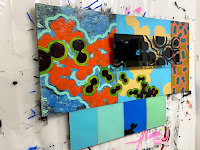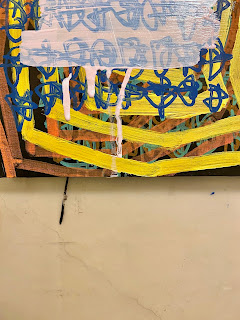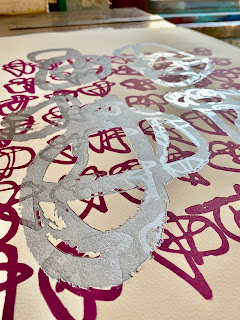This morning, I was attempting to describe a dream I had last night to my girlfriend and failed miserably, yet again. I was laying in bed, staring at the ceiling concentrating hard, trying to tell her about what it was like and what was going on in it, but couldn't. Beyond a few words about what I could describe, I was at a loss as to what to tell her about what I could see in my mind's eye about the experience. Images of the dream where still very fresh in my mind, but it was really tough translating what I had experienced in dream time.
The key word here is 'experienced'. I haven't done much research into dreams, but being that they are a perpetual and integral part of my existence, I can say with some clarity that dreams are pure experience that can barely be translated in a woke state of mind. My inability to recall large swaths of dreams comes from the fact that they are unadulterated, unfiltered experiences that resist translation into our conscious and (we think) rational vocabulary of words. No matter how hard I try, I have always come up short when attempting to relay to someone large portions of my dreams. i can go a whole day, even more, replaying aspects of the dream to myself, but will not be able to describe them to someone else. Dreams are so singularly ultra personal to us that we lack the ability to relay the information that will make real sense to someone else.
This is the same thing that happens when you try to explain a concert that you attended to someone else after the fact:
Them: "How was the concert"
You: "Oh, wow, it was the greatest concert EVER!"
Them: "What was so great about it?"
You: "It was just fucking amazing!"
Them: *states blankly*
You: "I mean, the lead singer was all like *WAAAAAHHH* and the guitarist was all like *wild air-guitaring gestures* and ..."
Them: *staring blankly*
This brings me to a point about creativity and the folly of translating ideas from the visual to the written in an effort to give other people a way to understand what we do. Artist statements exist to grant viewers and others a way of understanding your work and motivations behind making it. Many artists, myself included, sometimes find it hard to try and encapsulate our creative experiences into a written form that lacks the ability to properly relate the artists' experience of making the work. Most of us want to give viewers a way into the work by writing about our processes and influences, we don't normally talk about the deep, concentrated state of mind we might be in when making the work. However, that deeper state of mind is where I often begin when I'm writing artist statements.
When an artist is engaged in the making of their work, they are having a singular experience that no one else can imagine, much like how we go through life-there's nothing about how we deal with it that anyone else can understand, not completely from our perspective. They can only relate through empathy and/or having gone through similar situations. None of that is a substitute for how each of us experiences anything. Our creative visions, and the execution of them, are ours alone. When we attempt to talk about what we do, verbally or written, we are often at a loss for words. In our artist statements, we trip over ourselves attempting to make our internal journeys accessible to an external public.
Why is this so difficult? Because, like dreams, our art making is pure, unadulterated EXPERIENCE! When I'm painting, I'm in a mental space that defies the laws of time, physics and the physical, just like dreams. In dreams, our subconscious minds override our "rational", woken thought processes, allowing for a more unfiltered experience that even we don't always have the ability to control. There is the concept of lucid dreaming, but I have to do more reading on it to feel capable of understanding and writing about it. For my purposes here, I'm sticking with what I know of dreams and not having control over them.
So, what I'm basically getting to is that trying to translate creative thought processes and experiences into written and verbal mediums is very similar to explaining dreams. We literally can't. We've had to find physical language that most of us agree on in order to make our visual language and actions more understandable to others. It's difficult enough to figure out what we're doing ourselves most of the time. Usually, when working, we're in a constant state of existing in two (maybe more) mental planes at once: the creative space of the work we're making and the here and now. Constantly moving back and forth between what we know of as our physical reality and the realities of the creative work space in our heads.
Artist statements have always been a challenge and now, having thought about the reasons why, based on my "aha" moment today, I have a better understanding of why, at least for me. My artist statements always feel stuck in a certain moment while my creative mind is continually evolving. Often, once I've gotten about midway through a new painting, my mind has already processed present challenges that I may pursue in the next piece or something further down the road. There is this constant swirl of thoughts about the work that makes a written artist statement just about moot. However, because there is a need to provide some justification for what we're doing to show jurors, grant committees, art school faculty, collectors and the public, we have to be able to capture some of the elusive alchemy of what we do and make in the written word. Of course, not every person who makes use of their creativity has to do this, but for the rest of us, it is a necessity.
The good thing about writing artist statements is that it can give us some amount of clarity about what we're doing and why. While I love unfiltered creativity, I still think that it's good to have some idea about what's influencing us, even if it turns out to be something completely mundane, which, honestly, often it often is. My goal over the years with maintaining and updating my artist statement has been to make it as general as possible, without being too vague and within a certain parameter of concerns. I have found that this way, I'm able to update my statement for different purposes (grants vs. specific exhibitions, etc...) without losing sight of the overall concept of the work and with having to make more and more minor changes along the way. Sometimes, only a word or two need to be changed in order to fulfill a mandate about what I'm doing in the work currently.
The experience in making a of a work of art is, like dreams, on a lot of levels, still unexplainable outside of it's visual incarnation. That unexplainable bit of mystery is what makes creativity special, what makes us all special because no one can truly understand the mechanics of the singular experience of living nor of creating and therein likes the magic.
TM























